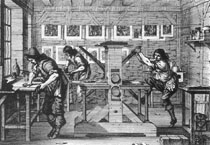The printing process
 The main features of creating a
design, inking the plate, and printing impressions using a press have been outlined above.
Unsurprisingly, the different techniques in the intaglio process could be combined on a
single plate: mezzotints often had areas of engraved detail, and many engravers first etched
a lot of background detail onto a plate before continuing the design with a burin.
The main features of creating a
design, inking the plate, and printing impressions using a press have been outlined above.
Unsurprisingly, the different techniques in the intaglio process could be combined on a
single plate: mezzotints often had areas of engraved detail, and many engravers first etched
a lot of background detail onto a plate before continuing the design with a burin.
In all processes, the printing matrix (the block or plate) could be re-used numerous times, either to create more impressions, or, after reworking, to create different states. A block or plate could have almost limitless printed states, each state the result of some alteration to the matrix, whether through minor reworking or more significant re-engraving—indeed, it was possible to smooth down an entire metal plate and re-use it for a completely different image. Woodblocks were more durable than the metal plates used in the intaglio process. Repeated printings in a press eventually wore down copper plates, so a printmaker was often required to rework the plate during the process to maintain the quality of the image. This applied particularly to mezzotints, where the large presence of copper burr on the roughened surface could be flattened quite rapidly under pressure, causing an increasing indistinctness in the impressions. A very common example of a different state of a print results from this reworking or retouching of the plate.
Another common example of a different state is the proof. A number of different proofs could be made before the final published state was reached, each being a way of checking the progress of the design. The most common proofs are those of intaglio prints before lettering is added. The task of adding lettering to a print was usually performed by a specialist lettering engraver. Lettering could often be quite extensive, including, for example, mottos, scriptural references, and other text, and frequently a title or short description of the print. It was also very common for it to contain production details about the print: who designed it (or the artist after whom the design was taken), who engraved it, and who published it, often including the address of the publisher. Latin terms were usually used to identify the different roles: ‘fecit’ (often abbreviated to ‘fec’ or ‘fe’) or ‘sculpsit’ (often abbreviated to ‘sculp’ or ‘sc’) denoted the engraver or printmaker; ‘invenit’ (often abbreviated to ‘inv’ or ‘in’) or ‘pinxit’ (often abbreviated to ‘pinx’) denoted the designer or artist; and ‘excudit’ (often abbreviated to ‘exc’ or ‘ex’) indicated the publisher. Many different states are the result of a change in publication information, usually when the plate has been passed onto a different publisher: the old publication detail would be erased and replaced by the new information.